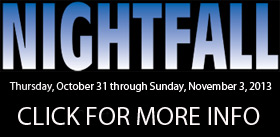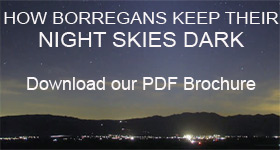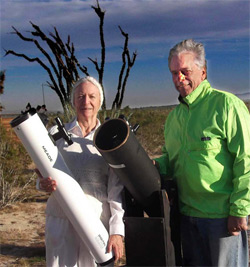


Borrego Springs is incredibly lucky to have a dark night sky. This is due to its
isolated location, the surrounding mountains, and the open space in the
Anza-Borrego Desert State Park. The town was granted Dark Sky Community status
in 2009 by the International Dark-Sky Association
www.darksky.org , the only town
in California to be so awarded. Residents, visitors, amateur astronomers,
and photographers treasure the valley’s dark sky.
But will it always be so? To maintain the dark sky in our Borrego
village good lighting practices are essential, by both businesses and homeowners.
What
have we done to preserve and protect our dark skies?
Here are some steps many have taken.

-
Use the right amount
of light for the task, not more than necessary. "More light" is not
necessarily good design. Simply use lower wattage or fewer bulbs to reduce the
brightness.
-
Replace older porch
lights. Compact fluorescents or LED fixtures are good alternatives and will
save on your electric bill.
-
Use the right amount
of light for the task, not more than necessary. "More light" is not
necessarily good design. Simply use lower wattage or fewer bulbs to reduce the
brightness.
-
Replace older porch
lights. Compact fluorescents or LED fixtures are good alternatives and will
save on your electric bill.
|
Milky Way over Borrego Springs
Early on the morning of
May 16, 2010, the Milky Way arched over the eastern horizon. This
180-degree panorama was shot in nine segments and carefully stitched together in
the computer. East is in the center, north to the left and south to the right.
© Photo by Dennis Mammana
|
|
Check out this
fantastic new video of Borrego night skies.
|
|
 |
BORREGO SPRINGS
INTERNATIONAL DARK SKY COMMUNITY
On July 31, 2009, the International Dark-Sky Association designated Borrego
Springs as the second International Dark Sky Community.
|
| This recognizes
the exceptional commitment of Borrego Springs to dark sky protection and
restoration throughout the community. IDA, a Tucson-based non-profit
organization dedicated to preserving the nighttime environment, established
its recognition program in 2 ds that protect the natural night sky and ensure the continuation of
this protection through community directives. |
|
|
-
Use timer controls,
motion sensors, or dimmer switches to insure that lights are ON when you need
them and OFF when you don’t need them.
-
Shine the light down
where it is needed. Stand off your property, even across the street, and look
at your porch light. If you can see the exposed bulb, then it is not properly
shielded. Can the angle
or location of the fixture be adjusted? Can you fashion some shading? If not,
consider upgrading the lamp.
-
Use small wattage
lights for illuminating landscaping or building accents. The subtle accent of
carefully placed, modest lighting can be appropriate to our desert habitat.
-
Change out yard
lights Mercury vapor globes are particularly bad because their blue light
destroys our eyes’ dark adaptation. Use low pressure sodium lamps (yellow),
which are also more economical. These bulbs are excellent for broad outdoor
areas, such as street lighting, parking lots,
and security illumination.
Thoughtful nighttime
lighting is the key to reducing light pollution. The options come at a variety
of costs, but there is something to fit every budget. Proper lighting saves
money! Residents and business owners may
contact the Dark Sky Coalition for an evaluation of their lighting and
information on suitable fixtures,
orientation, retrofits, suppliers, and changes that will save money and energy.
Click to download our PDF Brochure.
|
|
|
Borrego Springs has long been a haven for star gazers, both professional and
amateur. Rated by USA Today as one of the top ten stargazing locations in
the nation, the community prides itself on its dedication to the whole
desert experience.
Surrounded by the 600,000-acre Anza-Borrego Desert
State Park, Borrego Springs offers a remote desert landscape within easy reach of urban
areas, 88 miles from San Diego.
|
 |
 |
Astronomy with Dr.
Jim & Grace Rickard For more than 25
years Jim and Grace, both longtime ABDNHA members, have been conducting popular star gazing
activities in Borrego Springs. They enjoy sharing their telescopes
to observe celestial objects, pointing out the constellations, and considering
the possibility of “life out there” with Borrego Valley residents
and visitors.
James Rickard has had a 40 year research
career in both optical and radio astronomy and as a university
professor. |
| After
obtaining a PhD from University of Maryland, he and his wife Grace
spent a number of years in Chile, where he was employed as a staff
astronomer at the European Southern Observatory. He came to Borrego
Springs as a staff member at the Clark Lake Radio Observatory in
1977. In 1994 he took a teaching position at San Diego State
University, Imperial Valley campus and retired in 2004.
Check our schedule for astronomy
activities. |
|
The committee responsible for the Dark Sky efforts in Borrego Springs is comprised of
disparate vocations, including professional and amateur astronomy, natural
history associations, and authors. “The application to the IDA [by Borrego
Springs] really is a testament to their dedication for dark skies. By
collaborating with all the key stakeholders, the committee was able to achieve
broad community support, which is one of the key elements to this award,” said
Kim Patten, Programs Director for the IDA. “The efforts of the Borrego Springs Dark-Sky Coalition serve to involve the
whole community in dark sky preservation through increased awareness, education,
and availability of fixtures that better shield and direct light where it’s
needed, while helping to save energy and keep the desert skies dark for
stargazing, scientific study, and for all those who just enjoy the wonder of the
night sky,” wrote Bill Horn, supervisor for the fifth district of the San Diego
Board of Supervisors.
ABOUT INTERNATIONAL DARK SKY ASSOCIATION
The IDA is a 501(c)(3) not-for-profit organization dedicated to preserve and
protect the nighttime environment and our heritage of dark skies. Headquartered
in Tucson, AZ with a branch office in Washington, DC and satellite offices in
Hever, Belgium and Turramurra, Australia, IDA has membership in 70 countries. |
|
|

|
|

|

